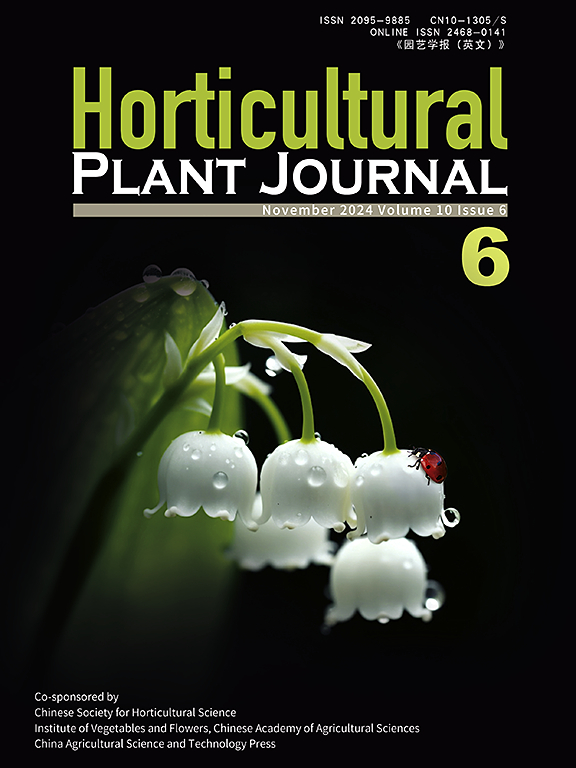大白菜等位基因突变验证了 BrWax1 在蜡生物合成中的功能
IF 5.7
1区 农林科学
Q1 HORTICULTURE
引用次数: 0
摘要
角质蜡的主要功能是防止非气孔失水,而缺蜡使植株外表光亮则会影响作物的品质。此前,我们通过 SSR 标记在天然突变体'08A235-2'中绘制了缺蜡基因 BrWax1 的图谱,并预测 Bra013809(BrWax1)为大白菜(Brassica rapa L. ssp. pekinensis)的候选基因。为了验证BrWax1的功能,从大白菜的EMS诱变群体中筛选了两个等位蜡晶缺乏突变体wdm4和wdm8,应用wdm4鉴定突变基因,发现AT4G24510(AtCER2)的同源基因BraA01g015290.3C是候选基因。Brara_Chiifu_V1.5 中的 Bra013809 和 Brara_Chiifu_V3.0 中的 BraA01g015290.3C 在十字花科数据库中被注释为同一个基因。在 wdm4 中,BrWax1 上的一个 SNP(C 到 T)导致了基因的停止增殖;在 wdm8 中,BrWax1 上的一个 SNP(G 到 A)导致了 38 个碱基的缺失,从而导致了第 190 个氨基酸的停止增殖。这些结果最终验证了 BrWax1 在蜡生物合成中的功能。我们的研究结果强调了 BrWax1 基因在大白菜角质蜡生物合成中的关键作用,并认为该基因有可能成为培育光泽外观的宝贵遗传资源。本文章由计算机程序翻译,如有差异,请以英文原文为准。
BrWax1 function in wax biosynthesis was verified by allelic mutations in Chinese cabbage
The primary function of cuticular wax is to prevent non-stomatal water loss, while the wax deficiency conferring a glossy appearance on plants is conductive to crop commodity qualities. We previously mapped a wax-deficient gene BrWax1 in a natural mutant ‘08A235-2’ by SSR marker, and predicted Bra013809 (BrWax1) as the candidate gene in Chinese cabbage (Brassica rapa L. ssp. pekinensis). In order to verifying the function of BrWax1, two allelic wax-crystal deficiency mutants wdm4 and wdm8 from an EMS mutagenesis population of Chinese cabbage were screened. wdm4 was applied to identify the mutant gene, with the finding that BraA01g015290.3C, the homologous of AT4G24510 (AtCER2), was the candidate gene. Bra013809 in Brara_Chiifu_V1.5 and BraA01g015290.3C in Brara_Chiifu_V3.0 were annotated as the same gene in Brassicaceae Database. A SNP (C to T) on BrWax1 in wdm4 resulted in a stopgain, and a SNP (G to A) on BrWax1 in wdm8 led to the deletion of 38 bases which caused a stopgain at the 190th amino acid. These results finally verified the function of BrWax1 in the wax biosynthesis. Our findings emphasize the crucial role of the BrWax1 gene in cuticular wax biosynthesis in Chinese cabbage and suggest its potential as a valuable genetic resource for breeding for glossy appearance.
求助全文
通过发布文献求助,成功后即可免费获取论文全文。
去求助
来源期刊

Horticultural Plant Journal
Environmental Science-Ecology
CiteScore
9.60
自引率
14.00%
发文量
293
审稿时长
33 weeks
期刊介绍:
Horticultural Plant Journal (HPJ) is an OPEN ACCESS international journal. HPJ publishes research related to all horticultural plants, including fruits, vegetables, ornamental plants, tea plants, and medicinal plants, etc. The journal covers all aspects of horticultural crop sciences, including germplasm resources, genetics and breeding, tillage and cultivation, physiology and biochemistry, ecology, genomics, biotechnology, plant protection, postharvest processing, etc. Article types include Original research papers, Reviews, and Short communications.
 求助内容:
求助内容: 应助结果提醒方式:
应助结果提醒方式:


